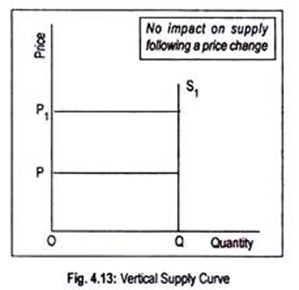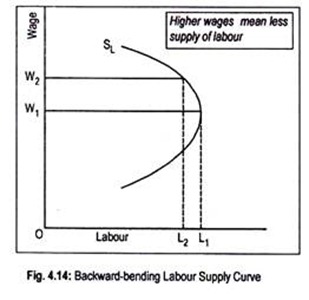The following points highlight the four exceptions of the law of supply.
1. Firstly, the supply curve of rare goods (such as the artwork of a dead painter) or non-reproducible goods is a vertical straight line.
An unchanged quantity is offered for sale at all possible prices. In this case, the supply curve becomes perfectly inelastic. Land is also completely inelastic in supply. This is shown in Fig. 4.13. SS1 supply curve shows that whatever the price of the commodity or land (even if it is zero), supply of the commodity/land is always OQ.
2. Secondly, the law of supply breaks down in the case of labour supply curve. In Fig. 4.14, labour supply curve is backward bending due to the operation of income effect and substitution effect of wage rate changes. Below the wage rate OW1, as wage rate rises, supply of labour tends to rise. Here substitution effect is stronger than the income effect.
But beyond OW1 wage rate, any rise in it will cause labour to work less and will induce him to take more leisure. Thus, income effect becomes stronger than the substitution effect. As a result, the supply curve of labour becomes backward bending.
3. Thirdly, if firms anticipate that the product prices will fall much in the near future, they will sell more now just to clear their stocks of goods. Such possibility may arise in the short run.
4. Finally, the supply curve may be negative sloping in the share market. As the share market is characterized by uncertainty, people anticipate the change in prices of shares.
ADVERTISEMENTS:
When the price of a share falls, people may expect that its price will fall further. In view of this expectation and anticipation regarding future price of shares, they sell more (less) now when its price falls (rises). This means that the supply curve for such shares is a downward sloping one.

